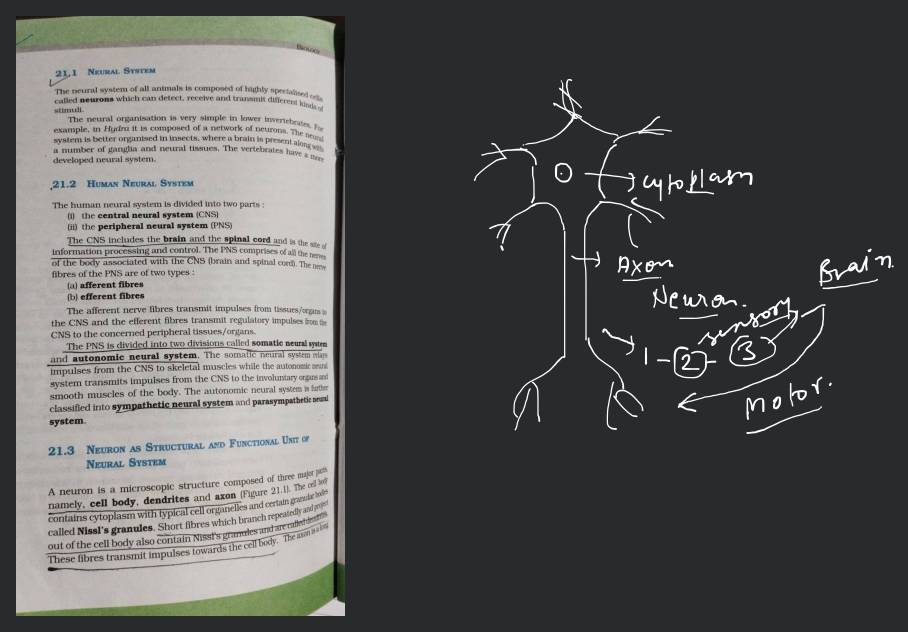Question
Question asked by Filo student

21. 1 NeURAL Sxstem The neural system of all animals is composed of highly specialised cells called neurons which can detect, receive and transmit different kinds of stimuli. The neural organisation is very simple in lower invertebrates, For example, in Hydra it is composed of a network of neurons. The neural system is better organised in insects, where a brain is present along with a number of ganglia and neural tissues. The vertebrates have a more developed neural system. HumaN NeURAL System The human neural system is divided into two parts : (i) the central neural system (CNS) (ii) the peripheral neural system (PNS) The CNS includes the brain and the spinal cord and is the site of information processing and control. The PNS comprises of all the nerves of the body associated with the CNS (brain and spinal cord). The nerve fibres of the PNS are of two types: (a) afferent fibres (b) efferent fibres The afferent nerve fibres transmit impulses from tissues/organs to the CNS and the efferent fibres transmit regulatory impulses from the CNS to the concerned peripheral tissues/organs. The PNS is divided into two divisions called somatic neural system and autonomic neural system. The somatic neural system relays impulses from the CNS to skeletal muscles while the autonomic neural system transmits impulses from the CNS to the involuntary organs and smooth muscles of the body. The autonomic neural system is further classified into sympathetic neural system and parasympathetic neural system. 21.3 NEURON AS STRUCTURAL AND FUNCTIONAL UNIT OF NEURAL SYSTEM A neuron is a microscopic structure composed of three major parts. namely, cell body, dendrites and axon (Figure 21.1). The cell body contains cytoplasm with typical cell organelles and certain granular bodes called Nissl's granules. Short fibres which branch repeatedly and procet out of the cell body also contain Nissi's gianrutes and are cattect enn mites These fibres transmit impulses towards the cell body. The axon is a 1006
Found 8 tutors discussing this question
Discuss this question LIVE
14 mins ago

One destination to cover all your homework and assignment needs
Learn Practice Revision Succeed

Instant 1:1 help, 24x7
60, 000+ Expert tutors

Textbook solutions
Big idea maths, McGraw-Hill Education etc

Essay review
Get expert feedback on your essay

Schedule classes
High dosage tutoring from Dedicated 3 experts
Practice more questions on Human Physiology
Question 3
Medium
Views: 5,295
Question 4
Medium
Views: 6,007
Students who ask this question also asked
Question 1
Views: 6,026
Question 2
Views: 5,912
Question 3
Views: 5,875
Question 4
Views: 5,464


Stuck on the question or explanation?
Connect with our Biology tutors online and get step by step solution of this question.
231 students are taking LIVE classes
| Question Text | 21. 1 NeURAL Sxstem
The neural system of all animals is composed of highly specialised cells called neurons which can detect, receive and transmit different kinds of stimuli.
The neural organisation is very simple in lower invertebrates, For example, in Hydra it is composed of a network of neurons. The neural system is better organised in insects, where a brain is present along with a number of ganglia and neural tissues. The vertebrates have a more developed neural system.
HumaN NeURAL System
The human neural system is divided into two parts :
(i) the central neural system (CNS)
(ii) the peripheral neural system (PNS)
The CNS includes the brain and the spinal cord and is the site of information processing and control. The PNS comprises of all the nerves of the body associated with the CNS (brain and spinal cord). The nerve fibres of the PNS are of two types:
(a) afferent fibres
(b) efferent fibres
The afferent nerve fibres transmit impulses from tissues/organs to the CNS and the efferent fibres transmit regulatory impulses from the CNS to the concerned peripheral tissues/organs.
The PNS is divided into two divisions called somatic neural system and autonomic neural system. The somatic neural system relays impulses from the CNS to skeletal muscles while the autonomic neural system transmits impulses from the CNS to the involuntary organs and smooth muscles of the body. The autonomic neural system is further classified into sympathetic neural system and parasympathetic neural system.
21.3 NEURON AS STRUCTURAL AND FUNCTIONAL UNIT OF NEURAL SYSTEM
A neuron is a microscopic structure composed of three major parts. namely, cell body, dendrites and axon (Figure 21.1). The cell body contains cytoplasm with typical cell organelles and certain granular bodes called Nissl's granules. Short fibres which branch repeatedly and procet out of the cell body also contain Nissi's gianrutes and are cattect enn mites These fibres transmit impulses towards the cell body. The axon is a 1006 |
| Updated On | Feb 2, 2023 |
| Topic | Human Physiology |
| Subject | Biology |
| Class | Class 11 |
| Answer Type | Video solution: 1 |
| Upvotes | 126 |
| Avg. Video Duration | 6 min |




